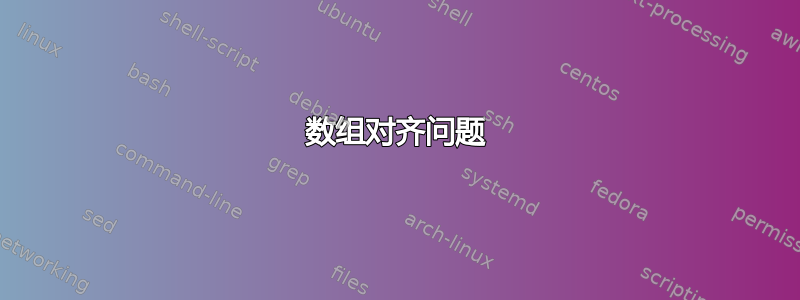
我遇到了数组对齐的问题。
请找到以下代码:
\documentclass[12 pt, a4paper]{book}
\usepackage{multicol}
\usepackage{geometry}
\geometry{
a4paper,
total={170 mm,257 mm},
left=20 mm,
top=20 mm,
}
\usepackage{amsmath,bm}
\usepackage{amsfonts}
\usepackage{amssymb}
\usepackage{soul}
\usepackage{indentfirst}
\usepackage[utf8]{inputenc}
\usepackage{palatino}
\usepackage[dvipsnames]{xcolor}
\usepackage{graphicx}
\usepackage{fancyhdr}
\usepackage{array}
\usepackage{enumitem}
\usepackage{mathtools}
\usepackage{cancel}
\usepackage{arydshln}
\setlength{\parindent}{2em}
\newcommand{\wt}[2]{\underset{\substack{\textstyle\uparrow\\\hidewidth\mathstrut#2\hidewidth}}{#1}}
\definecolor{mygray}{gray}{0.6}
\begin{document}
\textbf{Solution :}\\
\[
\left.
\hspace{1 cm}
\begin{array}{cccccc}
& & 1 & 0 & 1 & 0 \\
\times & & & 1 & 0 & 1 \\
\hline
& \underline{1} & 1 & 0 & 1 & 0 \\
& 0 & 0 & 0 & 0 & \\
1 & 0 & 1 & 0 & & \\
\hline
1 & 1 & 0 & 0 & 1 & 0 \\
\end{array}
\right. \hspace{0.25 cm}\vline \hspace{0.1 cm} \text{\parbox[t]{13 cm}{As, the product of binary multiplication would always be less than 2. It won't generate any carry.}}
\begin{array}{ccccccccc}
& & \textbf{Product/Sum} & & \textbf{Base} & & \textbf{Carry} & & \textbf{Result} \\
1 + 0 + 1 & = & 2 > 1 & = & 2 & \times & 1 & + & 0 \\[0.2 cm]
\end{array}
\]
\end{document}
得到的输出如下:
正如我们在图片中看到的,第二个数组与文本右侧对齐。我希望该数组位于文本下方。
有人能帮我解决这个问题吗?
答案1
可能不太优雅,因为我使用嵌套表格来定位数学元素、文本和线条。
\documentclass[12 pt, a4paper]{book}
\usepackage{multicol}
\usepackage{geometry}
\geometry{
a4paper,
total={170 mm,257 mm},
left=20 mm,
top=20 mm,
}
\usepackage{amsmath,bm}
\usepackage{amsfonts}
\usepackage{amssymb}
\usepackage{soul}
\usepackage{indentfirst}
\usepackage[utf8]{inputenc}
\usepackage{palatino}
\usepackage[dvipsnames]{xcolor}
\usepackage{graphicx}
\usepackage{fancyhdr}
\usepackage{array}
\usepackage{enumitem}
\usepackage{mathtools}
\usepackage{cancel}
\usepackage{arydshln}
\setlength{\parindent}{2em}
\newcommand{\wt}[2]{\underset{\substack{\textstyle\uparrow\\\hidewidth\mathstrut#2\hidewidth}}{#1}}
\definecolor{mygray}{gray}{0.6}
\usepackage{calc}
\begin{document}
\textbf{Solution :}
\begin{tabular}{p{0.25\textwidth-2\tabcolsep-\arrayrulewidth}|p{0.75\textwidth-2\tabcolsep}}
\(\begin{array}[t]{cccccc}
& & 1 & 0 & 1 & 0 \\
\times & & & 1 & 0 & 1 \\
\hline
& \underline{1} & 1 & 0 & 1 & 0 \\
& 0 & 0 & 0 & 0 & \\
1 & 0 & 1 & 0 & & \\
\hline
1 & 1 & 0 & 0 & 1 & 0 \\
\end{array}\)
&
\begin{tabular}[t]{@{}p{0.75\textwidth-2\tabcolsep}@{}}
As, the product of binary multiplication would always be less than 2. It won't generate any carry. \\
\hdashline
\[\begin{array}{ccccccccc}
& & \textbf{Product/Sum} & & \textbf{Base} & & \textbf{Carry} & & \textbf{Result} \\
1 + 0 + 1 & = & 2 > 1 & = & 2 & \times & 1 & + & 0 \\[0.2 cm]
\end{array}\]
\end{tabular}
\end{tabular}
\end{document}
答案2
为了不用猜测右侧材料的宽度,可以使用并在其中tabularx嵌套。arraytabular
\documentclass{article}
\usepackage{geometry}
\usepackage{amsmath,bm}
\usepackage{tabularx,array}
\usepackage{arydshln}
\geometry{
a4paper,
total={170 mm,257 mm},
left=20 mm,
top=20 mm,
}
\begin{document}
\noindent\textbf{Solution:}
\[
\begin{tabularx}{\textwidth}{@{} c | X @{}}
$\begin{array}{cccccc}
& & 1 & 0 & 1 & 0 \\
\times & & & 1 & 0 & 1 \\
\hline
& \underline{1} & 1 & 0 & 1 & 0 \\
& 0 & 0 & 0 & 0 & \\
1 & 0 & 1 & 0 & & \\
\hline
1 & 1 & 0 & 0 & 1 & 0 \\
\end{array}$ &
\begin{tabular}{@{}p{\linewidth}@{}}
As the product of binary multiplication would always be less than~$2$,
it won't generate any carry.
\\[2ex]
\hdashline
\[\begin{array}{ccccccccc}
& & \textbf{Product/Sum} & & \textbf{Base} & & \textbf{Carry} & & \textbf{Result} \\
1 + 0 + 1 & = & 2 > 1 & = & 2 & \times & 1 & + & 0 \\[0.2 cm]
\end{array}\]
\end{tabular}
\end{tabularx}
\]
\end{document}
答案3
我提出了这个变体代码,也基于 tabularx,但使用matrix环境和\Longstack虚线下的部分:
\documentclass{article}
\usepackage{geometry}
\usepackage{amsmath,bm}
\usepackage{tabularx}
\usepackage{arydshln, booktabs,}
\usepackage[usestackEOL]{stackengine}
\geometry{a4paper, total={170 mm,257 mm}, left=20 mm, top=20 mm}
\begin{document}
\noindent\textbf{Solution:}
\[
\begin{tabularx}{\textwidth}{@{} c | X @{}}
$\begin{matrix}
& & 1 & 0 & 1 & 0 \\
\times & & & 1 & 0 & 1 \\
\midrule
& ^{\underline{1}} & 1 & 0 & 1 & 0 \\
& 0 & 0 & 0 & 0 & \\
1 & 0 & 1 & 0 & & \\
\midrule
1 & 1 & 0 & 0 & 1 & 0 \\
\end{matrix}$\enspace &
\begin{tabular}{@{}p{\linewidth}@{}}
As the product of binary multiplication would always be less than~$2$,
it won't generate any carry.
\\[2ex]
\hdashline
\stackMath
\[ 1 + 0 + 1 = \Longstack{\textbf{Product/Sum} \\ 2 > 1} = \Longstack{ \textbf{Base}\\ 2} \times \Longstack{\textbf{Carry}\\ 1}
+ \Longstack{\\\textbf{Result}\\0} \]
\end{tabular}
\end{tabularx}
\]
\end{document}







